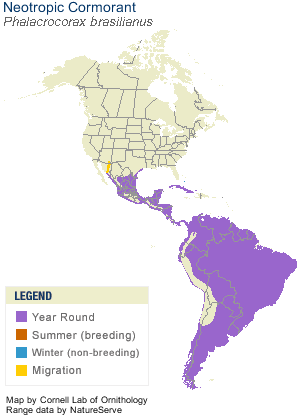Photo:Hans Hillewaert/Wiki Commons
The Neotropic Cormorant, Phalacrocorax brasiliensis, is one to watch for in Ohio. I believe we could be considered well overdue for an appearance by this diminutive relative of the Double-crested Cormorant. New Jersey birders are relishing that state's first record as I write this, and with luck Ohio birders will soon confirm this species in our state.
Neotropic Cormorants are very similar to the Double-crested Cormorant, and vagrants are likely to be fraternizing with that species. The first thing that will probably catch your eye is the size differential - the Neotropic Cormorant is noticeably smaller than its robust brethren. It's over a half-foot shorter in length, and a full foot shorter in the wingspan department. Neotropics also weigh about a pound less on average, and that translates to a bird that appears daintier than a Double-crested. The tail also looks big in proportion to the rest of the bird. Problem is, there are two subspecies of Double-crested Cormorant (normally occurring in Florida and the Caribbean) that are also noticeably smaller than the typical Double-crested Cormorant subspecies that we get in this part of the world. Upshot: you can't go on size alone for a positive identification. The elfin Double-crested Cormorant subspecies could also conceivably appear here, too.
Rather than me rehashing field marks here, consult your Sibley or other good guide for identification characters. And go on high alert if you do spot a tiny cormorant.
This fine map by the Cornell Lab of Ornithology shows the overall distribution of the Neotropic Cormorant. It's much more widespread in the Middle and South Americas than it is north of the Mexican border.
This is the Birds of North America Online map, and it gives us more detail regarding the northern limits of the Neotropic Cormorant's range. The dashed lines and outlying red dots indicate vagrancy, although I'm not sure the Pennsylvania record is correct. At least I couldn't find verification on the PA rare birds committee website. Even if it is in error, Pennsylvania will probably get one soon. This is a cormorant on the march. The overall population is growing, and new nesting colonies are cropping up outside of traditional breeding areas.
The number of Midwestern and Great Lakes region records has soared in the last decade or so. Illinois has had at eight since 1992, and Indiana has had at least five since 2011. A Neotropic Cormorant in 2012 was practically within a stone's throw of Cincinnati, and another was found in the state just a few days ago.
Kentucky is up to at least two records - 2007 and 2013 - and just across the International border at Point Pelee in Ontario, Canada, they've found three in the past few years, including last year. Point Pelee is only 23 miles from Kelleys Island in Ohio waters. Even Michigan has had one, in 2008.
You get my point. Neotropic Cormorant is a very likely candidate to appear in Ohio, so don't ignore those cormorants!
+Hans+Hillewaert+wiki+commons.jpg)


1 comment:
This species could be a true plague if rest near a populated place
Post a Comment